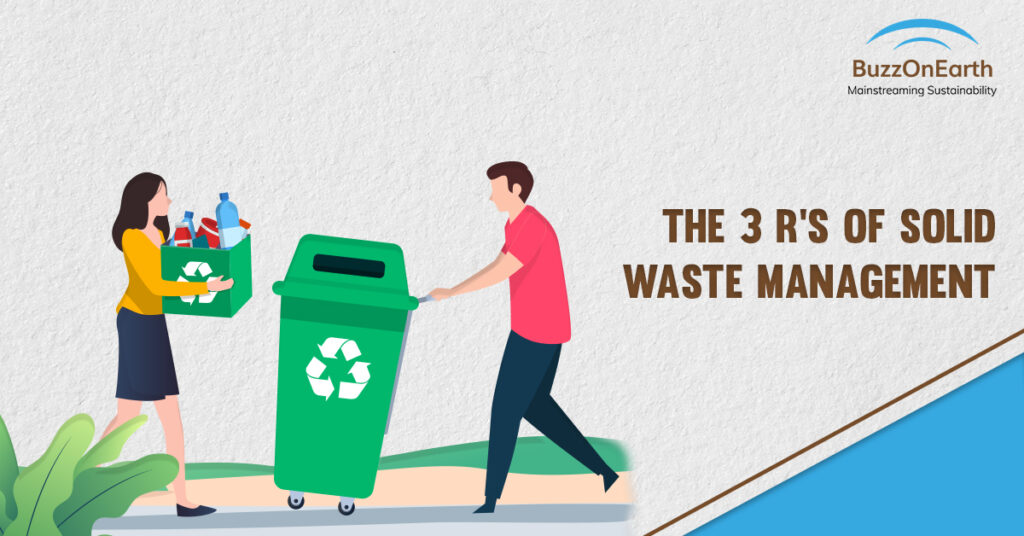Introduction
Humans generate garbage, which continuously degrades the ecosystem. Municipal solid waste, general trash collected by municipalities, is a frequent form of rubbish. It is mostly produced by households, street cleaning, business activity, and building or demolition waste.
This might range from farming to everyday food consumption. We may not be able to eliminate trash disposal, but we can make a substantial contribution to reducing waste creation and so helping to protect our ecosystem. Waste management entails carrying out the 3R’s waste management actions (Reduce Reuse Recycle).
The Concept of 3R’s of Solid Waste Management
The 3R (Reduce Reuse Recycle) Concept is essentially a series of actions for appropriately managing waste. The first goal is to decrease trash creation, followed by reuse and recycling to give waste materials a second opportunity before being disposed of in a landfill. After the 3R concept, the 5R concept is introduced throughout time.
The 5R Concept adds two more phases to the waste management process: Recover, which involves converting items that can no longer be recycled into energy sources or ecologically beneficial products to keep them out of landfills. The final stage is disposal, which allocates waste to the landfill that can no longer be recycled or repaired. The reversed triangle 3R (Reduce Reuse Recycle) idea shows how much waste volume should be managed in each step. This means that the majority of waste generation should be reduced from the start.
Only when the production of trash cannot be prevented are goods reused; one form of reuse is through the upcycling process or the creation of handicrafts. When materials can no longer be reused, the trash is recycled and melted, diced, and moulded into a new product, which may have a lower quality. The loss in quality of recycled materials and the energy and resources required to recycle trash are two of numerous reasons why recycling is not the primary priority of effective waste management. The primary goal is to reduce/prevent waste creation from the start (reduce).
The 3 R’s of Solid Waste Management
The 3R’s stand for Reduce Reuse Recycle. Here, we discuss all three in detail.
- As you might expect, since it is the first of the three R’s, reducing is the best approach to managing solid waste. It’s pretty simple: the less you consume, the less trash you generate. This R creates the most concern among consumers since we tend to believe that we won’t be able to make a difference if we cut down on everything. However, this is not the case. You may significantly reduce your trash without drastically affecting your lifestyle by simply doing a few things to cut back.
- Purchasing items with little packaging. Did you realise that product packaging accounts for 30% of all garbage in our landfills? When shopping, pick goods that come in a single bog or bag rather than double or triple packed.
- Purchasing items in bulk. By purchasing multiples of the same item simultaneously, you decrease the overall quantity of packing you will face.
- Try to avoid using throwaway items: paper plates, cups, and plastic utensils, in particular.
- Purchase long-lasting products. Look into the history and reviews of the purchase, especially if it is a significant investment. By purchasing something that will last, you may help keep garbage out of landfills for a longer period.
- The second R stands for reusing. With the rise of upcycling and DIY projects all over the internet, this one is becoming increasingly popular. When you reuse something instead of tossing it away, you keep waste out of landfills while also creating something new. Again, a fast online search will yield a plethora of options, or you may try any of the following:
- Don’t toss damaged objects away; many of them may be repurposed and transformed into wonderful new products!
- Instead of using plastic wrap, use sealable containers.
- Purchase reusable shopping bags or carry old plastic bags with you to the store.
- Investigate upcycling options for ordinary home objects; many have other applications you may not have considered.
- Another alternative is to shop at secondhand or resale stores. As a result, the goods will be entirely new for you while also assisting in the reuse of someone else’s potential garbage.
- The third and most well-known, R, stands for recycling. As you may be aware, recycling is the process of remanufacturing a product to be marketed as new. Aside from the essentials like paper, plastic, glass, and cardboard, many materials may be recycled that you may not be aware of. Remember that recycling only works if you finish the process by purchasing recycled products. Begin recycling right now by performing any of the following:
- Check with your local garbage collection service to see whether they provide recycling as well. This can make recycling even simpler.
- Check with your local recycling centre to discover what goods are accepted.
- Start a recycling programme at the office.
Conclusion
Solid waste management is one of the most pressing issues confronting many communities across the world. The idea of the solid waste management hierarchy, commonly known as the 3Rs (reduce reuse recycle), provides feasible solutions to the sustainable management of wastes while simultaneously meeting targets for zero waste discharges.

